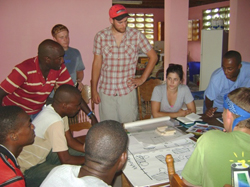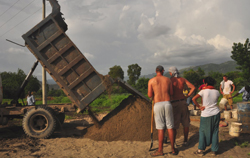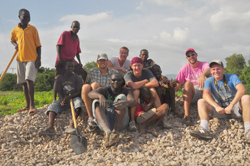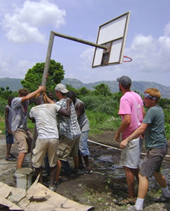ISU students design community center from shipping containers for La Croix, Haiti
10-25-10
![]() In Ames,
architecture students and Assistant Professor Nadia Anderson
(right) discuss ideas for recycling shipping containers as a
community center for La Croix, Haiti. Photo by Bob
Elbert.
In Ames,
architecture students and Assistant Professor Nadia Anderson
(right) discuss ideas for recycling shipping containers as a
community center for La Croix, Haiti. Photo by Bob
Elbert.
Contacts:
Nadia Anderson, Architecture, 515-294-0339, nanderso@iastate.edu
Jasmine Singh, Architecture-professional degree senior, 712-251-5690, jsingh@iastate.edu
Teddi Barron, News Service, (515) 294-4778, tbarron@iastate.edu
ISU students design community center from shipping containers for La Croix, Haiti
AMES, Iowa -- Some Iowa State University architecture students are creating a community center out of recycled shipping containers in a Haitian village. This fall, they will test their design ideas and construction techniques on a shipping container in their own neighborhood.
Last summer, the eight students spent a week in La Croix, an agricultural community of about 15,000 people, where they teamed up with Hope on the Horizon Youth Mission. Now, they're taking an independent study with Assistant Professor of Architecture Nadia Anderson to develop the details of their design. A "practice" container has been delivered and set up for them to work on at Howe's Welding and Metal Fabrication, 811 S. Duff, Ames.
 ISU architecture
students discuss plans with La Croix residents. Photo by
Nadia Anderson.
ISU architecture
students discuss plans with La Croix residents. Photo by
Nadia Anderson.
The community center is the dream of Silentor Esthil-Henderson, a La Croix native who graduated last spring from Iowa State. The center will be part of the mission's K-12 school, which serves 1,500 children. The Iowa State students envision it as the town hub for sports, recreational and learning activities. Such a place is needed because many teens leave in search of summer activities in the nearby port city of Gonaive and never return to finish school.
Recognizing resources, knowing conditions and learning logistics
While in La Croix, the architecture students laid out a regulation soccer field, set up a basketball court and secured swing sets in concrete. Part of the community center will be used for secure storage of sports equipment.
 Photo by Tom
Fraser.
Photo by Tom
Fraser.
The students learned a lot in a short time, said Anderson, who also visited La Croix.
"When they arrived, all they saw was how much was lacking," Anderson said. "By the time they left, they had completely changed their views. They were thinking in terms of all the great things that are there -- the culture, the people and all the assets."
Jasmine Singh, a senior in the architecture professional program, says the visit helped the students better understand the post-earthquake conditions and the logistics of constructing a building there.
"Since every design-build exercise requires significant engagement with the community, this visit helped us incorporate user needs, cultural preferences and community feedback into the evolution of the design," Singh said.
One practical lesson from the trip was about local practices for building foundations. They initially planned to pour concrete footings. However, Anderson said the poor quality of concrete work and difficult soil conditions steered them to focus on stone foundations -- commonly used in most of Haiti's houses and small, vernacular buildings.
"Stone elevates the building for moisture protection and doesn't require as much excavation as footings," Anderson explained. "And it's better in earthquakes because the building isn't mechanically pinned to anything, so it can actually move in the opposite direction of the ground. Structural failure occurs when the building has to move in the same direction as the ground."
 Photo by Tom
Fraser.
Photo by Tom
Fraser.
Engaging issues, empowering people, building capacity
The students plan to journey back to La Croix next summer to build the community center. In the meantime, Anderson and nine faculty colleagues from five design programs see the Haitian project as the beginning of something bigger. They've received a Miller Faculty Fellowship from Iowa State's Center for Excellence in Learning and Teaching to develop a global service and community engagement curriculum in the design college.
"The idea is that by engaging urgent issues such as disaster relief and persistent ones like poverty, students can learn to use design as a tool to create progressive change and empowerment," Anderson said.
And she wants to take a different group of students back to La Croix spring semester -- but without a specific project in mind.
"I want the students to identify needs and potential work," Anderson said. "Their learning experience will be through talking to people, understanding the situation and identifying what else we can do. Hopefully that (relationship between the college and La Croix) can develop on an ongoing basis."
Anderson says she learned "a lot in terms of outreach work." She quickly realized during her week in La Croix how fortunate she and the students were to "be embedded" in the village through the local mission and school.
"Then it becomes very much about empowerment and capacity building, not just coming in, doing a project and leaving," she said.
Anderson sees immense promise for the college and others across campus to sustain a long-term relationship with the town.
"There's great potential for micro-financing for craft businesses or small-scale ag," she said. "Food production is minimal and shortages are a huge problem. The landscape is completely deforested and the soil quality is poor. Sustainable agriculture is very much an interest."
The students have a similar idea. They started a company called Design Across Boundaries, which they hope to turn into a nonprofit organization.
"We created this organization because we're committed to improving the quality of life of people in need through sustainable and innovative design," said Singh. "And we want to educate the public about how design can benefit people in need."
-30-
 Photo by Nadia
Anderson.
Photo by Nadia
Anderson.